Stone/Coating Interaction and Durability of Si-Based Photocatalytic Nanocomposites Applied to Porous Lithotypes
Abstract
:1. Introduction
2. Materials and Methods
3. Results and Discussion
3.1. Characterization of Materials
3.1.1. Lithotypes
3.1.2. Protective Treatments
3.1.3. Absorption of Protective Treatments
3.2. Testing of Treated Lithotypes
3.2.1. Surface Colour Monitoring
3.2.2. Evaluation of Surface Morphology
3.2.3. Evaluation of Water Absorption and Surface Wettability
3.2.4. Evaluation of Photocatalytic Activity
3.3. Evaluation of the Durability of Protective Treatments
4. Conclusions
- The aggregate size and reactivity of the nanocomposite formulations and the mean pore diameter of stones turned out to be the most relevant factors determining their different absorption and penetration. The addition of TiO2 nanoparticles to alkylalkoxysilane matrices was shown to produce different effects depending on the reactivity of the matrix and the amount of nanoparticles. For the less reactive alcohol-based matrix (m-ANC), the nanocomposite retains the penetration ability and the protective properties of the silane precursor. For the more reactive water-based matrix (m-WNC) an effect on the aggregation state of the alkylalkoxysilane component was observed, resulting in a lower penetration of the composite product.
- Despite its lower penetration, the water-based nanocomposite WNC showed a good protective performance, particularly on the stone with higher mean pore diameter (Obernkirchen), indicating that the homogeneity of surface deposition and pore hydrophobization are more critical factors in determining a good water-repellency than is the total amount of applied product. The addition of nanoTiO2 to m-WNC did not modify the protective effectiveness of the matrix, whilst it gave rise to the desired significant photocatalytic activity. In the case of the alcohol-based nanocomposite ANC, in spite of the good penetration of the treatment and very good protective performance, the reduced amount of TiO2 nanoparticles did not allow to obtain distinct photocatalytic features. Moreover, this product caused a visible chromatic alteration on the siliceous stone (Obernkirchen) and in real conditions it is highly preferred to work with water-based formulations.
- The investigation of the durability of coatings upon exposure to UV light clarified that TiO2 nanoparticles, at the higher concentration found in WNC, contribute to a photo-induced oxidative degradation of the organic component of the matrix, revealed by FTIR analysis. Nevertheless, an important result of this study was that this degradation does not substantially compromise the effectiveness of the coating in reducing water capillary absorption, because it does not extend to the pore network under the surface where the coating imparts most of its water-barrier effect. Furthermore, the good interaction achieved between TiO2 nanoparticles and the embedding matrix in WNC, assessed through Raman analysis, resulted in a stable anchoring of nanoparticles to the stone surfaces even after prolonged exposure to in-lab simulated rain wash-out.
Supplementary Materials
Author Contributions
Funding
Acknowledgments
Conflicts of Interest
References
- Lackhoff, M.; Prieto, X.; Nestle, N.; Dehn, F.; Niessner, R. Photocatalytic activity of semiconductor-modified cement—Influence of semiconductor type and cement ageing. Appl. Catal. B 2003, 43, 205–216. [Google Scholar] [CrossRef]
- Chen, J.; Poon, C.-S. Photocatalytic construction and building materials: From fundamentals to applications. Build. Environ. 2009, 44, 1899–1906. [Google Scholar] [CrossRef]
- Quagliarini, E.; Bondioli, F.; Goffredo, G.B.; Licciulli, A.; Munafò, P. Smart surfaces for architectural heritage: Preliminary results about the application of TiO2-based coatings on travertine. J. Cult. Herit. 2012, 13, 204–209. [Google Scholar] [CrossRef]
- Bergamonti, L.; Alfieri, I.; Lorenzi, A.; Montenero, A.; Predieri, G.; Barone, G.; Mazzoleni, P.; Pasquale, S.; Lottici, P.P. Nanocrystalline TiO2 by sol–gel: Characterisation and photocatalytic activity on Modica and Comiso stones. Appl. Surf. Sci. 2013, 282, 165–173. [Google Scholar] [CrossRef]
- Munafò, P.; Goffredo, G.B.; Quagliarini, E. TiO2-based nanocoatings for preserving architectural stone surfaces: An overview. Constr. Build. Mater. 2015, 84, 201–218. [Google Scholar] [CrossRef]
- Quagliarini, E.; Graziani, L.; Diso, D.; Licciulli, A.; D’Orazio, M. Is nano-TiO2 alone an effective strategy for the maintenance of stones in cultural heritage? J. Cult. Herit. 2018, 30, 81–91. [Google Scholar] [CrossRef]
- Toniolo, L.; Gherardi, F. The protection of marble surfaces: The challenge to develop suitable nanostructured treatments. In Advanced Materials for the Conservation of Stone, 1st ed.; Hosseini, M., Karapanagiotis, I., Eds.; Springer: New York, NY, USA, 2017; Volume 1, pp. 57–78. ISBN 978-3-319-72259-7. [Google Scholar]
- Manoudis, P.N.; Tsakalof, A.; Karapanagiotis, I.; Zuburtikudis, I.; Panayiotou, C. Fabrication of super-hydrophobic surfaces for enhanced stone protection. Surf. Coat. Technol. 2009, 203, 1322–1328. [Google Scholar] [CrossRef]
- De Ferri, L.; Lottici, P.P.; Lorenzi, A.; Montenero, A.; Salvioli-Mariani, E. Study of silica nanoparticles—Polysiloxane hydrophobic treatments for stone-based monument protection. J. Cult. Herit. 2011, 12, 356–363. [Google Scholar] [CrossRef]
- Pinho, L.; Mosquera, M.J. Titania-silica nanocomposite photocatalysts with application in stone self-cleaning. J. Phys. Chem. C 2011, 115, 22851–22862. [Google Scholar] [CrossRef]
- Pinho, L.; Elhaddad, F.; Facio, D.S.; Mosquera, M.J. A novel TiO2–SiO2 nanocomposite converts a very friable stone into a self-cleaning building material. Appl. Surf. Sci. 2013, 275, 389–396. [Google Scholar] [CrossRef]
- Kapridaki, C.; Pinho, L.; Mosquera, M.J.; Maravelaki-Kalaitzaki, P. Producing photoactive, transparent and hydrophobic SiO2-crystalline TiO2 nanocomposites at ambient conditions with application as self-cleaning coatings. Appl. Catal. B 2014, 156–157, 416–427. [Google Scholar] [CrossRef]
- Kapridaki, C.; Maravelaki-Kalaitzaki, P. TiO2-SiO2-PDMS nano-composite hydrophobic coating with self-cleaning properties for marble protection. Prog. Org. Coat. 2013, 76, 400–410. [Google Scholar] [CrossRef]
- Pinho, L.; Rojas, M.; Mosquera, M.J. Ag-SiO2-TiO2 nanocomposite coatings with enhanced photoactivity for self-cleaning application on building materials. Appl. Catal. B 2015, 178, 144–154. [Google Scholar] [CrossRef]
- Gherardi, F.; Goidanich, S.; Dal Santo, V.; Toniolo, L. Layered Nano-TiO2 Based Treatments for the Maintenance of Natural Stones in Historical Architecture. Angew. Chem. Int. Ed. 2018, 57, 7360–7363. [Google Scholar] [CrossRef] [PubMed]
- Ksinopoulou, E.; Bakolas, A.; Moropoulou, A. Modifying Si-based consolidants through the addition of colloidal nano-particles. Appl. Phys. A 2016, 122, 267. [Google Scholar] [CrossRef]
- Aslanidou, D.; Karapanagiotis, I.; Lampakis, D. Waterborne superhydrophobic and superoleophobic coatings for the protection of marble and sandstone. Materials 2018, 11, 585. [Google Scholar] [CrossRef] [PubMed]
- Frigione, M.E.; Lettieri, M.T. Novel Attribute of Organic–Inorganic Hybrid Coatings for Protection and Preservation of Materials (Stone and Wood) Belonging to Cultural Heritage. Coatings 2018, 8, 319. [Google Scholar] [CrossRef]
- Gherardi, F.; Goidanich, S.; Toniolo, L. Improvements in marble protection by means of innovative photocatalytic nanocomposites. Prog. Org. Coat. 2018, 121, 13–22. [Google Scholar] [CrossRef]
- Colangiuli, D.; Calia, A.; Bianco, N. Novel multifunctional coatings with photocatalytic and hydrophobic properties for the preservation of the stone building heritage. Constr. Build. Mater. 2015, 93, 189–196. [Google Scholar] [CrossRef]
- Cappelletti, G.; Fermo, P.; Camiloni, M. Smart hybrid coatings for natural stones conservation. Prog. Org. Coat. 2015, 78, 511–516. [Google Scholar] [CrossRef]
- La Russa, M.F.; Rovella, N.; Alvarez De Buergo, M.; Belfiore, C.M.; Pezzino, A.; Crisci, G.M.; Ruffolo, S.A. Nano-TiO2 coatings for cultural heritage protection: The role of the binder on hydrophobic and self-cleaning efficacy. Prog. Org. Coat. 2016, 91, 1–8. [Google Scholar] [CrossRef]
- Milanesi, F.; Cappelletti, G.; Annunziata, R.; Bianchi, C.L.; Meroni, D.; Ardizzone, S. Siloxane-TiO2 hybrid nanocomposites. The structure of the hydrophobic layer. J. Phys. Chem. C 2010, 114, 8287–8293. [Google Scholar] [CrossRef]
- Spinella, A.; Bondioli, F.; Nasillo, G.; Renda, V.; Caponetti, E.; Messori, M.; Morselli, D. Organic-inorganic nanocomposites prepared by reactive suspension method: Investigation on filler/matrix interactions and their effect on the nanoparticles dispersion. Colloid Polym. Sci. 2017, 295, 695–701. [Google Scholar] [CrossRef]
- Gherardi, F.; Gulotta, D.; Goidanich, S.; Colombo, A.; Toniolo, L. On-site monitoring of the performance of innovative treatments for marble conservation in architectural heritage. Herit. Sci. 2017, 5, 1–15. [Google Scholar] [CrossRef]
- Carmona-Quiroga, P.M.; Martínez-Ramírez, S.; Viles, H.A. Efficiency and durability of a self-cleaning coating on concrete and stones under both natural and artificial ageing trials. Appl. Surf. Sci. 2018, 433, 312–320. [Google Scholar] [CrossRef]
- Munafò, P.; Quagliarini, E.; Goffredo, G.B.; Bondioli, F.; Licciulli, A. Durability of nano-engineered TiO2 self-cleaning treatments on limestone. Constr. Build. Mater. 2014, 65, 218–231. [Google Scholar] [CrossRef]
- Franzoni, E.; Fregni, A.; Gabrielli, R.; Graziani, G.; Sassoni, E. Compatibility of photocatalytic TiO2-based finishing for renders in architectural restoration: A preliminary study. Build. Environ. 2014, 80, 125–135. [Google Scholar] [CrossRef]
- Graziani, L.; Quagliarini, E.; Bondioli, F.; D’Orazio, M. Durability of self-cleaning TiO2 coatings on fired clay brick façades: Effects of UV exposure and wet & dry cycles. Build. Environ. 2014, 71, 193–203. [Google Scholar] [CrossRef]
- Maury-Ramirez, A.; Demeestere, K.; De Belie, N. Photocatalytic activity of titanium dioxide nanoparticle coatings applied on autoclaved aerated concrete: Effect of weathering on coating physical characteristics and gaseous toluene removal. J. Hazard. Mater. 2012, 211–212, 218–225. [Google Scholar] [CrossRef] [PubMed]
- Aldoasri, M.A.; Darwish, S.S.; Adam, M.A.; Elmarzugi, N.A.; Ahmed, S.M. Protecting of marble stone facades of historic buildings using multifunctional TiO2 nanocoatings. Sustainability 2017, 9, 2002. [Google Scholar] [CrossRef]
- Goffredo, G.B.; Terlizzi, V.; Munafò, P. Multifunctional TiO2-based hybrid coatings on limestone: Initial performances and durability over time. J. Build. Eng. 2017, 14, 134–149. [Google Scholar] [CrossRef]
- Calia, A.; Lettieri, M.; Masieri, M. Durability assessment of nanostructured TiO2 coatings applied on limestones to enhance building surface with self-cleaning ability. Build. Environ. 2016, 110, 1–10. [Google Scholar] [CrossRef]
- Scalarone, D.; Lazzari, M.; Chiantore, O. Acrylic protective coatings modified with titanium dioxide nanoparticles: Comparative study of stability under irradiation. Polym. Degrad. Stab. 2012, 97, 2136–2142. [Google Scholar] [CrossRef]
- Lazzeri, A.; Coltelli, M.B.; Castelvetro, V.; Bianchi, S.; Chiantore, O.; Lezzerini, M.; Niccolai, L.; Weber, J.; Rohatsch, A.; Gherardi, F.; et al. European Project NANO-CATHEDRAL: Nanomaterials for conservation of European architectural heritage developed by research on characteristic lithotypes. In Science and Art: A Future for Stone, Proceedings of the 13th International Congress on the Deterioration and Conservation of Stone, Glasgow, UK, 6–10 September 2016; Hughes, J., Howind, T., Eds.; University of the West of Scotland: Paisley, UK, 2016; Volume 1. [Google Scholar]
- Gherardi, F.; Roveri, M.; Goidanich, S.; Toniolo, L. Photocatalytic Nanocomposites for the Protection of European Architectural Heritage. Materials 2018, 11, 65. [Google Scholar] [CrossRef] [PubMed]
- Roveri, M.; Raneri, S.; Bianchi, S.; Gherardi, F.; Castelvetro, V.; Toniolo, L. Electrokinetic Characterization of Natural Stones Coated with Nanocomposites for the Protection of Cultural Heritage. Appl. Sci. 2018, 8, 1694. [Google Scholar] [CrossRef]
- European Committee for Standardization. EN 16581:2014. Conservation of Cultural Heritage—Surface Protection for Porous Inorganic Materials—Laboratory Test Methods for the Evaluation of the Performance of Water Repellent Products; European Committee for Standardization: Brussels, Belgium, 2014. [Google Scholar]
- European Committee for Standardization. EN 15886:2000. Conservation of Cultural Property—Test Methods—Colour Measurements of Surfaces; European Committee for Standardization: Brussels, Belgium, 2000. [Google Scholar]
- García, O.; Malaga, K. Definition of the procedure to determine the suitability and durability of an anti-graffiti product for application on cultural heritage porous materials. J. Cult. Herit. 2012, 13, 77–82. [Google Scholar] [CrossRef]
- European Committee for Standardization. EN 15801:2009. Conservation of Cultural Property—Test Methods—Determination of Water Absorption by Capillarity; European Committee for Standardization: Brussels, Belgium, 2009. [Google Scholar]
- European Committee for Standardization. EN 15802:2009. Conservation of Cultural Property—Test Methods—Determination of Static Contact Angle; European Committee for Standardization: Brussels, Belgium, 2009. [Google Scholar]
- Lezzerini, M.; Marroni, M.; Raneri, S.; Tamayo, S.; Narbona, B.; Fernández, B.; Weber, J.; Ghaffari, E.; Ban, M.; Rohatsch, A. D1.5—Mapping of Stones and Their Decay: Part I—Natural Stone Test Methods; NanoCathedral Project Grant Agreement No. 646178—Confidential Deliverable; Nano-Cathedral: Pisa, Italy, 2017; pp. 8–16. [Google Scholar]
- Demjén, Z.; Purkánszky, B.; Földes, E.; Nagy, J. Interaction of silane coupling agents with CaCO3. J. Colloid Interface Sci. 1997, 190, 427–436. [Google Scholar] [CrossRef]
- Kim, J.; Seidler, P.; Wan, L.S.; Fill, C. Formation, structure, and reactivity of amino-terminated organic films on silicon substrates. J. Colloid Interface Sci. 2009, 329, 114–119. [Google Scholar] [CrossRef] [PubMed]
- Charola, A.E. Water repellents and other “protective” treatments: A critical review. In Proceedings of the Hydrophobe III—3rd International Conference on Surface Technology with Water Repellent Agents, Hannover, Germany, 25–26 September 2001; Aedificatio Publishers: Hannover, Germany, 2001. [Google Scholar]
- Tanaka, K.; Capule, M.F.V.; Hisanaga, T. Effect of crystallinity of TiO2 on its photocatalytic action. Chem. Phys. Lett. 1991, 187, 73–76. [Google Scholar] [CrossRef]
- Ding, Z.; Lu, G.Q.; Greenfield, P.F. Role of the Crystallite Phase of TiO2 in Heterogeneous Photocatalysis for Phenol Oxidation in Water. J. Phys. Chem. B 2000, 104, 4815–4820. [Google Scholar] [CrossRef]
- Burgio, L.; Clark, R.J.H. Library of FT-Raman spectra of pigments, minerals, pigment media and varnishes, and supplement to existing library of Raman spectra of pigments with visible excitation. Spectrochim. Acta Part A 2001, 57, 1491–1521. [Google Scholar] [CrossRef]
- Venkatasubbu, G.D.; Ramakrishnan, V.; Sasirekha, V.; Ramasamy, S.; Kumar, J. Influence of particle size on the phonon confinement of TiO2 nanoparticles. J. Exp. Nanosci. 2014, 9, 661–668. [Google Scholar] [CrossRef]
- Morselli, D.; Niederberger, M.; Bilecka, I.; Bondioli, F. Double role of polyethylene glycol in the microwaves-assisted non-hydrolytic synthesis of nanometric TiO2: Oxygen source and stabilizing agent. J. Nanopart. Res. 2014, 16, 4519–4521. [Google Scholar] [CrossRef]
- Meroni, D.; Lo Presti, L.; Di Liberto, G.; Ceotto, M.; Acres, R.G.; Prince, K.C.; Bellani, R.; Soliveri, G.; Ardizzone, S. A close look at the structure of the TiO2-APTES interface in hybrid nanomaterials and its degradation pathway: An experimental and theoretical study. J. Phys. Chem. C 2017, 121, 430–440. [Google Scholar] [CrossRef] [PubMed]
- Manoudis, P.N.; Karapanagiotis, I.; Tsakalof, A.; Zuburtikudis, I.; Panayiotou, C. Superhydrophobic composite films produced on various substrates. Langmuir 2008, 24, 11225–11232. [Google Scholar] [CrossRef] [PubMed]
- Peña-Alonso, R.; Rubio, F.; Rubio, J.; Oteo, J.L. Study of the hydrolysis and condensation of γ- Aminopropyltriethoxysilane by FT-IR spectroscopy. J. Mater. Sci. 2007, 42, 595–603. [Google Scholar] [CrossRef]
- Blasucci, V.; Dilek, C.; Huttenhower, H.; John, E.; Llopis-Mestre, V.; Pollet, P.; Eckert, C.A.; Liotta, C.L. One-component, switchable ionic liquids derived from siloxylated amines. Chem. Commun. 2009, 1, 116–118. [Google Scholar] [CrossRef] [PubMed]
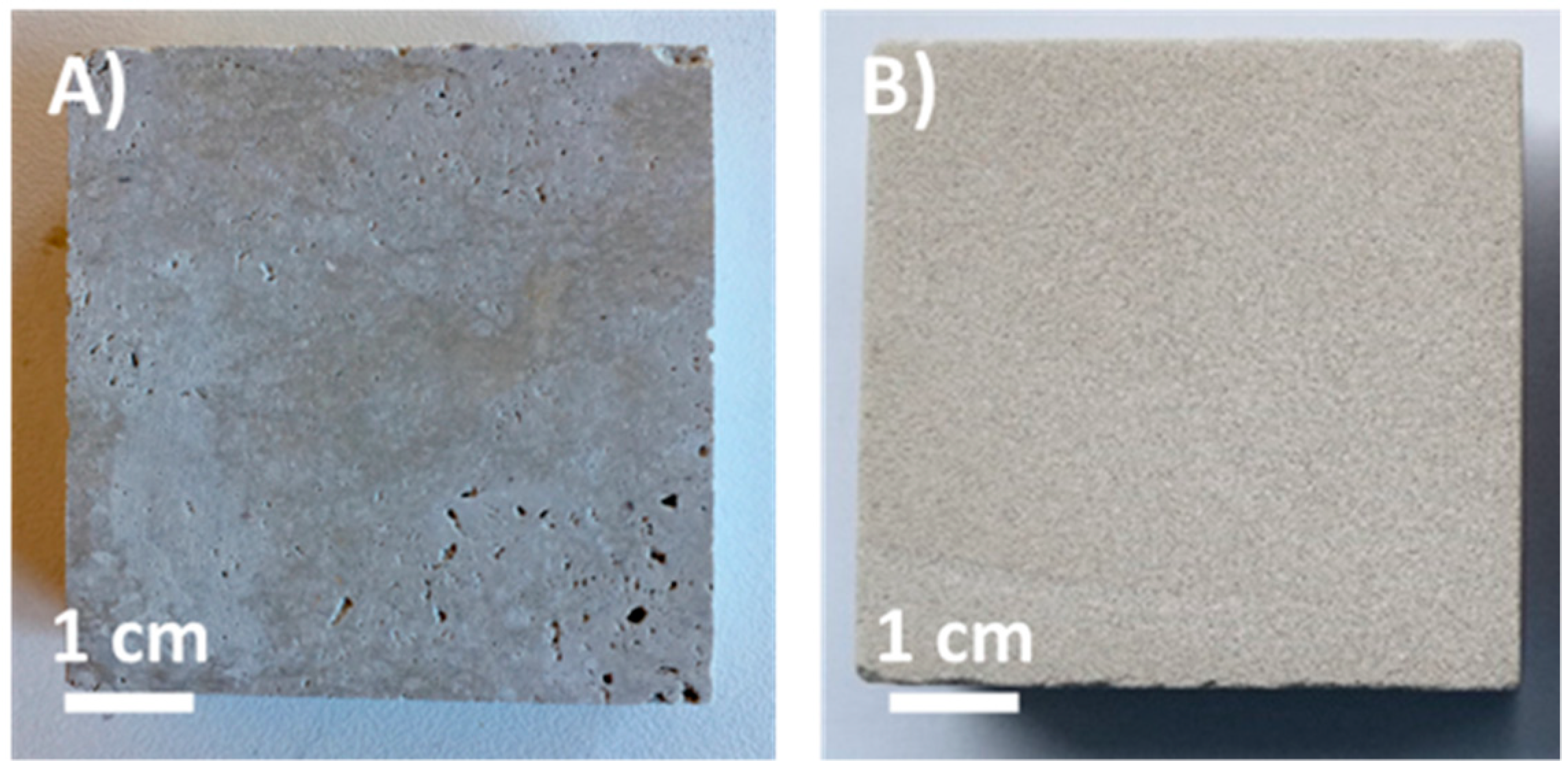

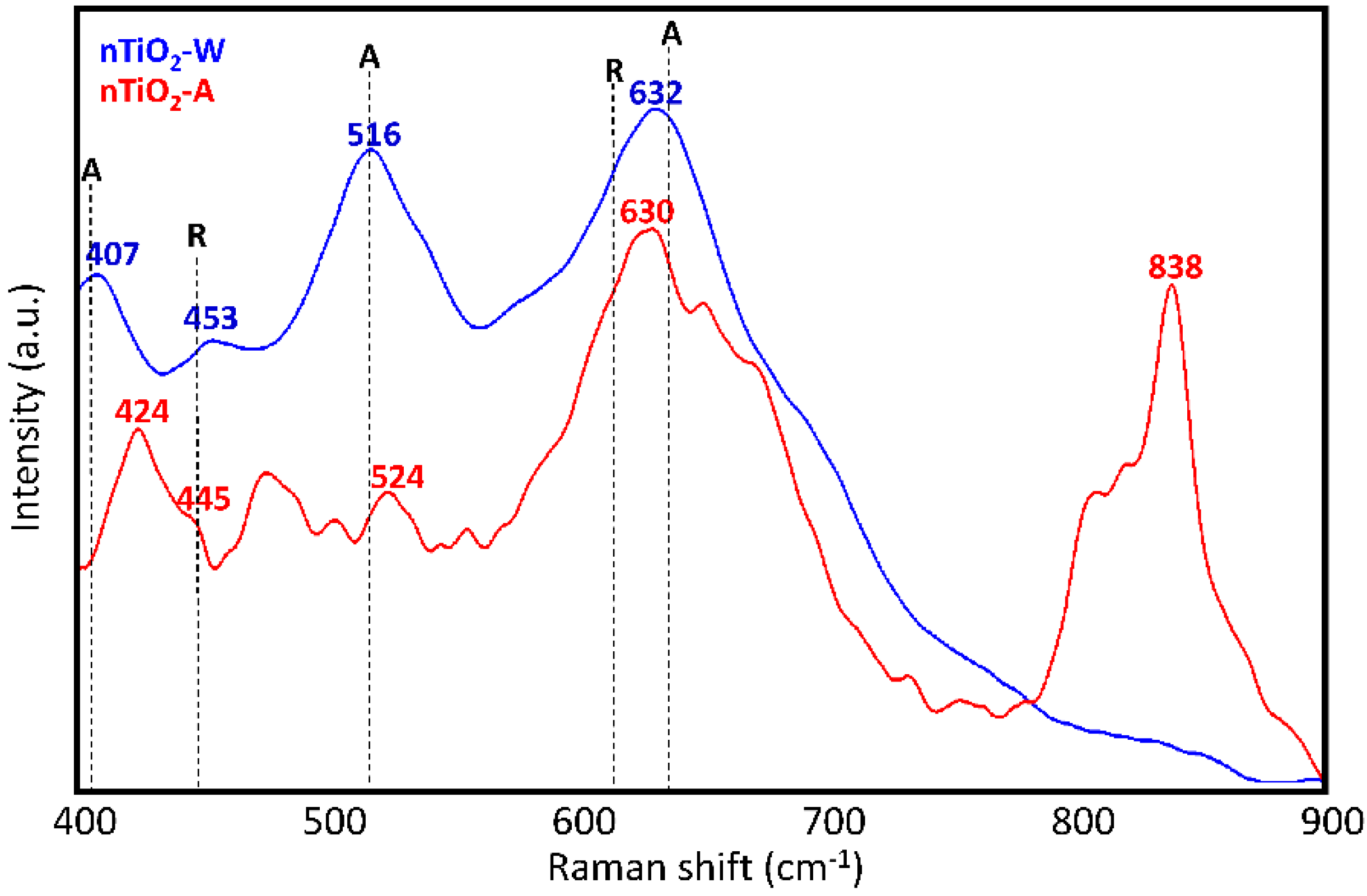
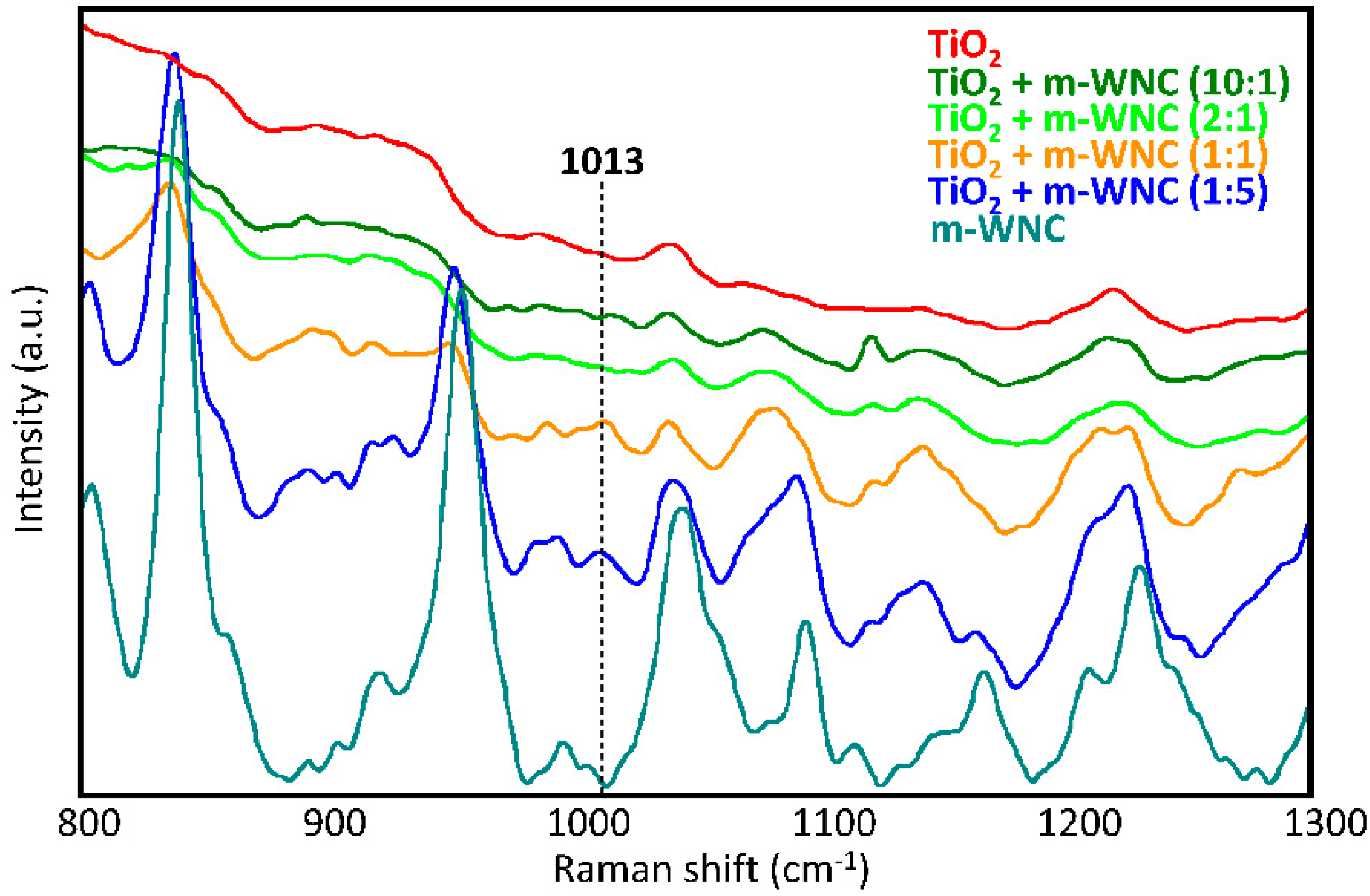
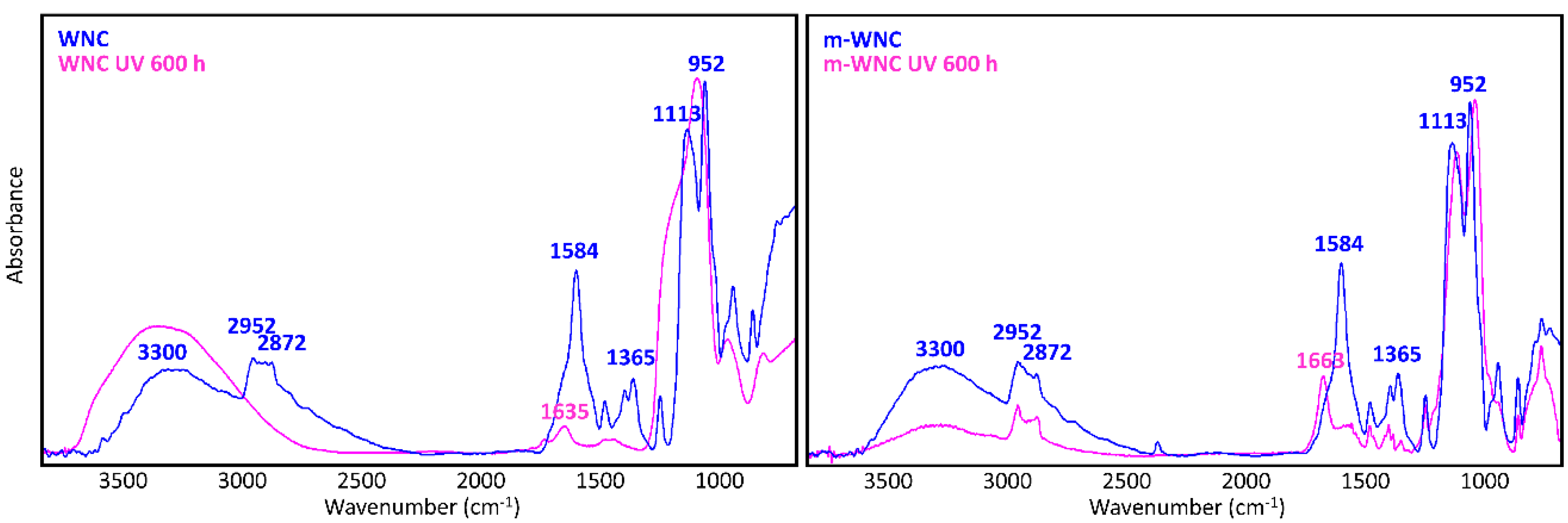

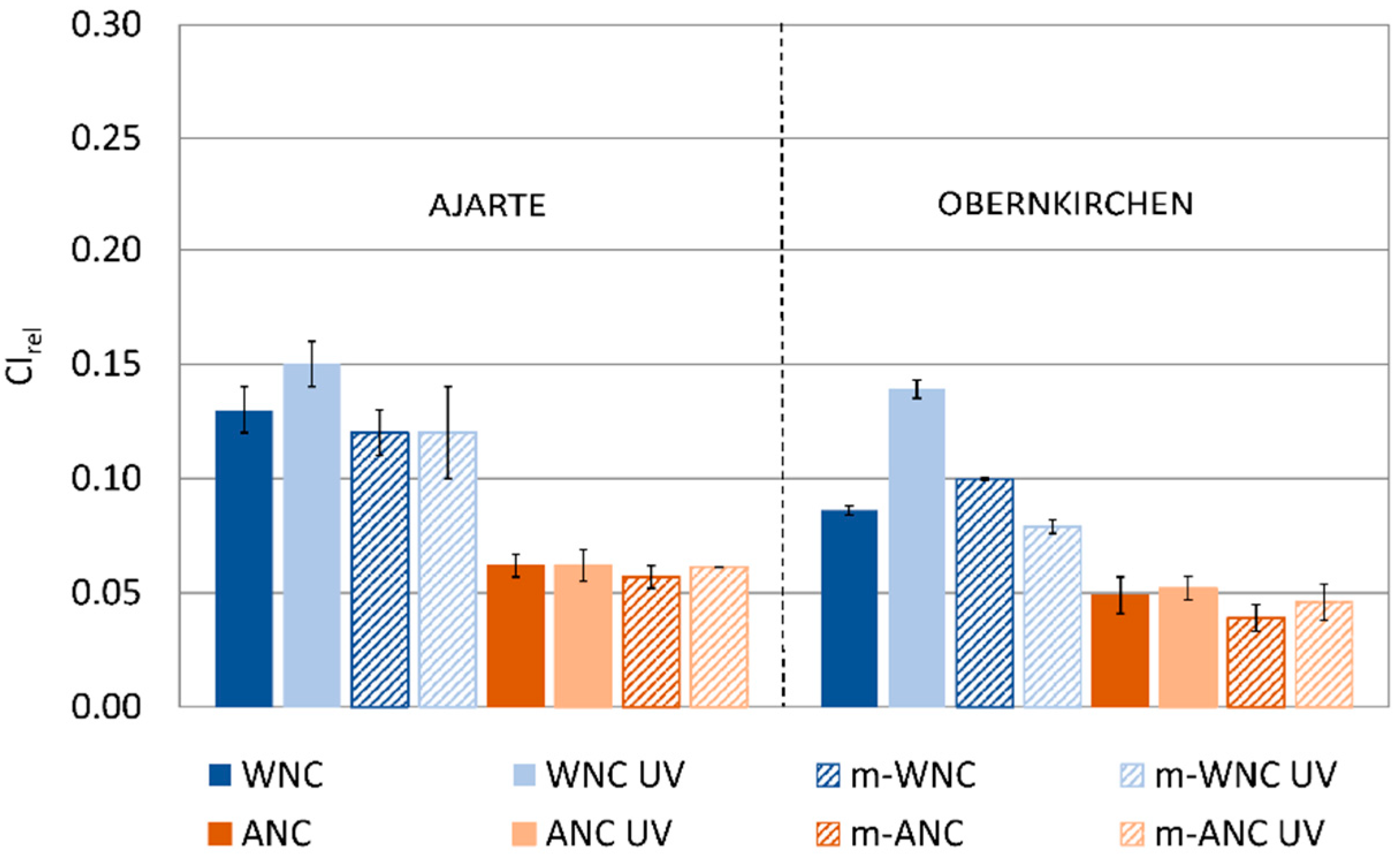

| Component | Description | Solvent | Concentration | NPs Size 1 |
|---|---|---|---|---|
| nTiO2-W | TiO2 NPs | water (pH 1.5) | 5.5% | 50 ± 10 |
| nTiO2-A | TiO2 NPs | 1,2-propanediol | 12% | 20 ± 5 |
| m-WNC | n-propyl trimethoxysilane tris(propyltrimethoxysilyl)amine formic acid | water (pH 4.5) | 15% | - |
| m-ANC | 2-methylpropyl trimethoxysilane ethyl orthosilicate butyl orthotitanate (cat.) | 2-propanol | 40% | - |
| Product | Solvent | Composition |
|---|---|---|
| WNC | water (pH 4.5) | 0.96% nTiO2-W 15% m-WNC |
| ANC | 2-propanol | 0.12% nTiO2-A 40% m-ANC |
| Density | Viscosity | Particle Size | |
|---|---|---|---|
| WNC | 1.03 | 10 ± 1 | 105.9 ± 0.4 1 |
| m-WNC | 1.03 | 10 ± 1 | 82.8 ± 0.2 |
| ANC | 0.84 | 7 ± 1 | 25 ± 1 1 |
| m-ANC | 0.84 | 11 ± 3 | - |
| WNC | m-WNC | ANC | m-ANC | |
|---|---|---|---|---|
| Ajarte | 122 ± 17 | 203 ± 47 | 408 ± 6 | 411 ± 7 |
| Obernkirchen | 74 ± 5 | 213 ± 1 | 236 ± 19 | 219 ± 5 |
| ΔE* | ΔL* | Δa* | Δb* | ||
|---|---|---|---|---|---|
| AJARTE | WNC | 1.5 ± 0.3 | −0.9 ± 0.3 | −0.36 ± 0.06 | 1.1 ± 0.3 |
| m-WNC | 1 ± 1 | −0.6 ± 0.7 | −0.3 ± 0.1 | 1.1 ± 0.9 | |
| ANC | 2.2 ± 0.6 | −2.0 ± 0.8 | 0.21 ± 0.09 | −0.3 ± 0.9 | |
| m-ANC | 4 ± 2 | −3 ± 1 | 0.3 ± 0.3 | 1.5 ± 0.6 | |
| OBERN. | WNC | 2.6 ± 0.6 | −2.3 ± 0.5 | 0.15 ± 0.08 | 1.1 ± 0.4 |
| m-WNC | 2.5 ± 0.9 | −1.7 ± 0.7 | 0.08 ± 0.09 | 1.8 ± 0.5 | |
| ANC | 10 ± 1 | −8 ± 1 | 1.3 ± 0.3 | 5 ± 1 | |
| m-ANC | 9 ± 1 | −7 ± 2 | 1.0 ± 0.2 | 4.7 ± 0.6 |
| Untreated | WNC | m-WNC | ANC | m-ANC | |
|---|---|---|---|---|---|
| Ajarte | 33 ± 3 | 5 | 1 | 37 | 38 |
| Obernkirchen | 7 ± 3 | 12 | 3 | 3 | 39 |
| Qi nt | Qi t | AC nt | AC t | CIrel | ||
|---|---|---|---|---|---|---|
| AJARTE | WNC | 430 ± 20 | 79 ± 6 | 4.2 ± 0.6 | 0.144 ± 0.007 | 0.132 ± 0.008 |
| m-WNC | 430 ± 30 | 79 ± 3 | 5.2 ± 0.9 | 0.132 ± 0.001 | 0.12 ± 0.01 | |
| ANC | 447 ± 3 | 36 ± 3 | 4.6 ± 0.8 | 0.112 ± 0.004 | 0.063 ± 0.005 | |
| m-ANC | 438 ± 2 | 34 ± 4 | 5.1 ± 0.2 | 0.106 ± 0.003 | 0.061 ± 0.008 | |
| OBERN. | WNC | 257 ± 6 | 33 ± 5 | 2.8 ± 0.2 | 0.076 ± 0.005 | 0.09 ± 0.01 |
| m-WNC | 250 ± 4 | 36.4 ± 0.7 | 3.4 ± 0.4 | 0.070 ± 0.004 | 0.099 ± 0.001 | |
| ANC | 260 ± 20 | 18 ± 4 | 3.7 ± 0.6 | 0.075 ± 0.006 | 0.052 ± 0.008 | |
| m-ANC | 240 ± 10 | 14 ± 5 | 3.2 ± 0.6 | 0.057 ± 0.005 | 0.05 ± 0.01 |
| θ nt | θ t | ||
|---|---|---|---|
| AJARTE | WNC | <10 1 | 131 ± 14 |
| m-WNC | 139 ± 3 | ||
| ANC | 138 ± 2 | ||
| m-ANC | 142 ± 4 | ||
| OBERN. | WNC | 21 ± 2 | 140 ± 2 |
| m-WNC | 138 ± 1 | ||
| ANC | 133 ± 1 | ||
| m-ANC | 137 ± 1 |
| D*PRODUCT/D*SILRES | ||||
|---|---|---|---|---|
| 30 min | 90 min | 150 min | ||
| AJARTE | WNC 1 | 5.6 | 3.9 | 3.3 |
| m-WNC | 0.7 | 0.6 | 0.6 | |
| ANC 1 | 0.2 | 2.0 | 2.0 | |
| m-ANC | 0.7 | 1.0 | 0.8 | |
| OBERN. | WNC | 4.7 | 5.2 | 3.7 |
| m-WNC | 0.8 | 1.1 | 0.5 | |
| ANC | 2.1 | 2.2 | 1.7 | |
| m-ANC | 1.1 | - | 0.7 | |
© 2018 by the authors. Licensee MDPI, Basel, Switzerland. This article is an open access article distributed under the terms and conditions of the Creative Commons Attribution (CC BY) license (http://creativecommons.org/licenses/by/4.0/).
Share and Cite
Roveri, M.; Gherardi, F.; Brambilla, L.; Castiglioni, C.; Toniolo, L. Stone/Coating Interaction and Durability of Si-Based Photocatalytic Nanocomposites Applied to Porous Lithotypes. Materials 2018, 11, 2289. https://doi.org/10.3390/ma11112289
Roveri M, Gherardi F, Brambilla L, Castiglioni C, Toniolo L. Stone/Coating Interaction and Durability of Si-Based Photocatalytic Nanocomposites Applied to Porous Lithotypes. Materials. 2018; 11(11):2289. https://doi.org/10.3390/ma11112289
Chicago/Turabian StyleRoveri, Marco, Francesca Gherardi, Luigi Brambilla, Chiara Castiglioni, and Lucia Toniolo. 2018. "Stone/Coating Interaction and Durability of Si-Based Photocatalytic Nanocomposites Applied to Porous Lithotypes" Materials 11, no. 11: 2289. https://doi.org/10.3390/ma11112289
APA StyleRoveri, M., Gherardi, F., Brambilla, L., Castiglioni, C., & Toniolo, L. (2018). Stone/Coating Interaction and Durability of Si-Based Photocatalytic Nanocomposites Applied to Porous Lithotypes. Materials, 11(11), 2289. https://doi.org/10.3390/ma11112289







